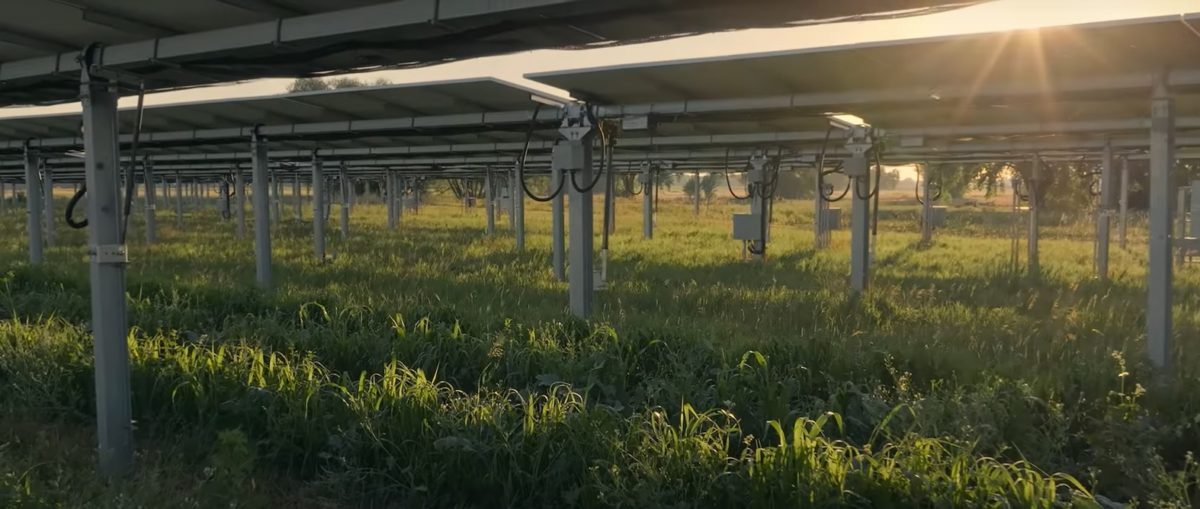Agrivoltaic systems, where solar photovoltaic arrays are co-located with crop or forage production, can alleviate the tension between expanding solar development and loss of agricultural land. However, the ecological ramifications of these arrays are not yet well known.
Agrivoltaics bring notable benefits, including creating microclimates for crops, shade to grazing animals, improved forage quality, and increasing farmer income and income stability. While the installation of traditional solar arrays tends to increase soil compaction, reduce soil carbon and nutrient content, and reduce water retention, care can be taken during the installation phase to minimize the impacts on soil and vegetation. Agrivoltaic solar arrays may be better able to maintain crucial ecosystem services such as carbon storage, water retention, and habitat quality.
A new report by Colorado State University used field measurements and a plant hydraulic model to quantify carbon-water cycling in a semi-arid perennial grassland growing beneath a single-axis tracking solar array in the Rocky Mountain State.
Although the solar array reduces light availability by 38% during the day, photosynthesis and above ground primary productivity were reduced by only 6–7% while evapotranspiration or the evaporation of water from soil into the atmosphere decreased by just 1.3%.
These minimal changes in carbon-water cycling occurred largely because the sample plants’ photosynthetic traits underneath the panels changed to take advantage of the dynamic shading environment.
The test results indicate that agrivoltaic systems can serve as a scalable way to expand solar energy production while maintaining ecosystem function in managed grasslands, especially in climates where water is scarce compared to sunlight.
Agrivoltaic systems are promising in water-limited regions such as the Western U.S. due to their capacity to moderate thermal environments and reduce plant water-use and soil evaporation. Semi-arid and arid grasslands are a favorable location for such arrays given their short-statured vegetation and relatively flat topography, the CSU report found.
The U.S. is home to close to 40 million acres of grassland for hay production and non-alfalfa forage. It has been estimated that close to 10 million acres of high-density photovoltaic systems are needed to achieve statewide decarbonization goals by 2050. Thus, the report notes that managed grasslands have the potential to house an increasing amount of collocated agrivoltaic systems at a meaningful scale while concurrently increasing land-use efficiency.
However, the CSU report affirms certain unknowns still exist about the long-term impacts of agrivoltaic systems, including the degree to which reductions in light availability will limit plant photosynthesis, and thus forage production.
Water retention in grassland agrivoltaics could also translate into enhanced ecosystem resistance to weather extremes such as droughts or heat waves.
Overall, many uncertainties remain regarding the highly dynamic microclimate within agrivoltaics, the physiological responses of plants to microclimate variability, and how solar arrays impact carbon and water cycling at decade-level time scale.
Jack’s Solar Garden
In the U.S., where the CSU study was undertaken at the first widely studied agrivoltaic project, Jack’s Solar Garden, a 1.2 MW, 3.5-acre solar field in Longmount, Colo., with new crops grown underneath since 2020, studies have been undertaken for just the last few years.
Widespread adoption of agrivoltaics in managed grasslands will depend, in part, on the degree to which ecosystem function within the array can be maintained despite reductions in light availability.
At Jack’s Solar Garden, the CSU study used plant hydraulics and soil hydrology to simulate grassland growth and hourly carbon-water fluxes over a 23-year time period forecast. Using single-axis tracking panels, common smooth brome pasture grass grows underneath and between the solar panels in 17 foot spaced rows.
The CSU model was measured with plant traits and driven by a combination of measured and reanalysis-derived weather data. The study group partitioned the agrivoltaic system into four locations:
- Areas underneath the eastern and western edges of the solar field receive additional precipitation from panel runoff, and experience full sunlight in the morning and afternoon, respectively.
- Locations between the panel rows experience a microclimate similar to a non-agrivoltaic grassland (with the exception of minor morning and afternoon shade).
- Locations directly under the solar panels are mostly shaded and receive reduced direct precipitation inputs. The CSU group compared these within-array locations to a control plot located 32 feet away that had similar vegetation composition and management history but not influenced by solar panels.
The impact of agrivoltaics on grassland function will likely differ across climates and species. While reductions in productivity are commonly observed in more moderate moisture ecosystems, drier regions may experience increases in plant growth under solar arrays due to more acute water limitation in those environments, the study found.
The CSU study was undertaken using C3 type grass, a cool season grass type found in cooler temperature environments and less sunlight requirements, with high moisture retention and high frost withstand. Future studies by the group will focus on C4 grassland plots, which are warmer environment, high light factor grass with lower moisture requirements.
The report was led by Steven A. Kannenberg of West Virginia University, with participation by Matthew Sturchio and Alan K. Knapp of Colorado State University, and Martin Venturas of Universidad Politécnica de Madrid.
This content is protected by copyright and may not be reused. If you want to cooperate with us and would like to reuse some of our content, please contact: editors@pv-magazine.com.









Climate change will only get worse. As the planet warms, agrivoltaics could be a win-win for farmers and consumers.
Good effort towards agritech